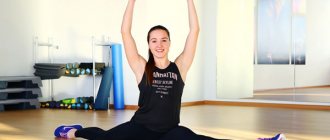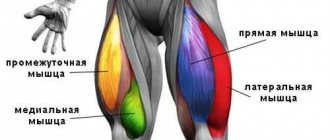The ability to do the cross split is an indicator of good flexibility and excellent physical fitness. This gymnastic element is much more difficult to perform compared to the longitudinal one. But despite the difficulties, many beginners and experienced athletes are trying to master it. Only desire and hard work allow them to achieve their desired goal.
Of course, it is easier for children to do the splits. Their muscle and bone tissue have not yet lost their natural elasticity, limiting the mobility of the body. But this does not mean that an adult will never be able to succeed in this matter. By following the technique, adhering to the recommendations and training regularly, you will be able to perform the cross splits at any age. We will tell you in detail how to realize this desire in today’s article.
What muscles need to be developed
When performing cross splits, a number of muscles are involved in the work:
- short, long, adductor femora magnus;
- tailoring;
- comb;
- gluteal;
- semitendinosus;
- popliteal;
- semimembranous.
To do the splits, you not only have to stretch the muscles and ligaments, but also significantly improve the mobility of the sacrum and hip joints. Therefore, it will not be possible to do the cross splits at home in record time. Get ready for a lot of hard work. It usually takes from several months to a year to master it.
Basic rules for beginners
- Have a great warm up! Before you start stretching, be sure to do some cardio, that is, run and jump intensely for at least 10 minutes so that you sweat.
- Relax! No matter how strange it may sound, stretching occurs at the moment of relaxation. When you experience muscle pain, under no circumstances should you strain or squeeze your muscles; on the contrary, relax. It is worth noting that severe pain cannot be tolerated, otherwise you can tear muscles and ligaments. The pain should be pleasant, or at least tolerable.
- Exercise regularly! There is strength in consistency. The optimal number of workouts is 5 times a week (to achieve quick results). One workout lasts 30 minutes (including 10 minutes warming up and 20 minutes stretching). If you wish, you can increase the stretching time depending on how you feel, but do not decrease it in any way.
What are the benefits of cross twine?
This type of split is a very impressive pose. But the benefits of its implementation are not limited to the aesthetic side alone. So, stretching on the back of the thigh helps:
- make the leg muscles strong and toned;
- work out the muscles of the back, lumbar region and abs;
- normalize the activity of the pelvic organs and genitourinary system;
- improve the elasticity of the ligaments and the mobility of the hip joints, which is especially good for women (makes it easier to bear a fetus and give birth to a healthy child).
In addition, stretching acts as an effective preventative against various pathologies of the abdominal cavity and gastrointestinal tract.
Possible variations
There are a large number of variations of the two forms of twine. There are seven subtypes of this gymnastic element.
Classical
It is the raising of the legs to a position in which the angle between the inner surfaces of the thighs is 180 degrees, in accordance with the above characteristics.
Performed on a flat surface or floor:
© khosrork — stock.adobe.com
Negative (sagging)
One of the most difficult types of twine. To perform it, you will have to acquire additional equipment, for example, chairs or a wall bars.
The main characteristic of this type is the angle between the thighs, which exceeds 180 degrees.
Performing this exercise requires high concentration and good muscle tone, as well as constant self-improvement. It is not available to everyone.
© zhagunov_a — stock.adobe.com
Horizontal
It consists of spreading your legs along the horizon line. It is a classic twine, usually performed on the floor. Hands are usually held straight in front of you or spread to the sides.
© Sergey Khamidulin — stock.adobe.com
Vertical
It differs from the previous one in the position of the legs in space - in this case they are located perpendicular to the horizon. While standing, a person leans on one of his legs and lifts the other into the air. A pylon or wall bars are often used as a support.
Vertical longitudinal twine:
© Prostock-studio — stock.adobe.com
Transverse modification must be done with hand support:
On hands
For this option, the athlete must have unique skills in balance and control of his own body. Standing in a handstand, the person slowly spreads his legs to the sides:
© fizkes — stock.adobe.com
Option with longitudinal twine on hands:
© master1305 — stock.adobe.com
Another variation is forearm stand:
© sheikoevgeniya — stock.adobe.com
Air
It is done in the air, most often in a jump, but some people know how to perform this element while standing still. By jumping and swinging his legs, a person achieves the desired turning angle in the air.
It is noteworthy that not all aerial twine masters can perform the classic one.
© Andrey Burmakin — stock.adobe.com
Lying on the floor
The main condition is to rest your back on a flat surface. From the starting position lying on the floor, a person spreads his legs to the sides, getting a transverse split:
© sonsedskaya — stock.adobe.com
To perform the longitudinal one, one leg is placed on the floor and the other is pulled towards the head, supported by hands:
© Artranq — stock.adobe.com
Warm up before exercise
Warm-up gymnastics is the most important stage on the path to performing the splits; the warm-up contains elements of yoga. It is necessary to warm up before every workout, without exception. After all, if the muscles are not sufficiently prepared and warmed up, the exercises will be ineffective.
The following are great warm-up exercises:
- running in place;
- jumping rope;
- swing your legs;
- squats;
- rotation of the legs in the hip and knee joints.
During preparation, you should also not forget about your arms and upper body. To eliminate the possibility of injury and make it easier to perform the main set of exercises, you need to warm up completely. Pull-ups on the horizontal bar and heavy dumbbells, of course, are not required. But a variety of rotations and arm swings, as well as push-ups, will come in handy. The main thing is not to overdo it. The warm-up should not end with a feeling of complete exhaustion. You can read about how to warm up properly in this article.
Don't forget that you need to practice in a warm room. If you get cold during a workout, your muscles won't be able to relax enough and will stretch worse.
Twine and half twine
The “split” figure has the following characteristics:
- The legs spread apart form a single line.
- When performed correctly, the angle between the legs is 180 degrees.
- The pelvic part is slightly turned forward.
© Vitaly Sova — stock.adobe.com
There is such a thing as half-split. The bent leg takes on the support, and the second leg is moved to the side or back and fully straightened.
© fizkes — stock.adobe.com
Half-split is used as a warm-up before actual stretching.
Cross split stretching exercises
Having warmed up thoroughly, you can move on to the basic movements that will help you perform the cross split. You must stay in each pose for at least 30 seconds (at the initial stage of training). In the future, the duration should be increased to 2-3 minutes.
Frog in a squat
Place your feet shoulder-width apart. Bend your legs, feet, knees and hips should be turned to the sides. As you exhale, slowly lower yourself down, trying to keep your pelvis as low as possible.
Now rest your elbows on your knees and push them back, continuing to stretch your pelvis towards the floor. At the same time, you should sway slightly, deepening the squat. Hold in this position for 30-40 seconds.
Frog
Get on all fours, spread your legs out to the sides as far as possible. At the same time, the palms rest on the surface of the floor, the shins are pressed. Now stretch forward, taking small “steps” with your hands, and push your knees even further to the sides. The pelvis should go as low as possible. Feel the stretch in your inner thighs.
When performing, do not lean forward or backward. Once you've completed the exercise, place your body weight on your forearms and move your legs toward the center to rise up.
Butterfly
Another effective exercise for cross splits.
Sit on the floor, bring your heels and feet together and pull them towards the groin area as much as possible. Try not to lift your knee joints off the floor. But if it doesn’t work out the first time, it’s okay. Over time, the muscles will become more flexible, and you will easily cope with the task.
Keep your back straight and your shoulders back. Tilt your head slightly. Now raise your knees and try to bring them together without lifting your feet from each other. It is allowed to help hold the position with your hands. Stay in this position for a few seconds, then lower your knees to the floor and pause again.
To complicate the exercise, extend your arms forward and stretch your body behind them, getting as close to the floor as possible.
Deep tilt
Stand straight, bring your legs together. As you exhale, without rounding your back, gently lean forward. Try to reach your palms to the surface of the floor or grab your ankles. Stay in this position for a while. Inhaling, return to the starting position.
Another variation of this exercise is with legs wide apart. In this case, it is supposed to alternately bend towards the right and left limbs.
Half twine
Take a sitting position, spread your legs as far apart as possible. Make sure your back remains straight. Now stretch your arms forward and bend down behind them as much as possible. Try to get your chest as close to the floor as possible. If you are flexible enough, you will be able to practically lie down. Don’t forget that your knees should not bend. Your heels should be on the floor and your toes should be pointed towards you.
To increase the load, return to the starting position and alternately reach for each leg. Perform 10-12 bends on each side.
Lying straight leg raise
Lie down on the floor. Raise your straight leg and clasp your shin with your palm. Try to bring the limb as close to your face as possible. If possible, do not bend the knee joint.
If difficulties arise with performing the exercise, you can use auxiliary equipment - a gymnastic elastic band. This will make it easier to pull your leg towards you. Remember that your back and lower back should be pressed firmly to the floor. Repeat the movement 8-10 times on each limb.
Side lunge
Stand up straight, straighten your back and straighten your shoulders. Now, as you exhale, take a wide step to the side, leg bent, shifting your body weight to the supporting limb. Bend over slightly and move your pelvis back, performing a deep squat so that your thigh is almost parallel to the floor.
The right leg at this moment should be straightened, the knee should be pulled up. Accordingly, the step should be wide enough. The farther you move your leg during a lunge, the more active your buttocks and inner thigh muscles work.
Leg spread against the wall
This exercise is perfect as a cross split stretch for beginners. It is much easier to perform compared to a similar option without support.
Sit on the floor near the wall. Push your back firmly towards her, as shown in the photo below, raising your legs up. As you exhale, bend your knees and smoothly slide your feet down (to the sides). At the same time, the buttocks are completely pressed against the wall, the sacrum is against the floor surface.
Now straighten your limbs, pull your feet towards you. Try to lower your legs as low as possible. Stay at the extreme point for a few seconds. If necessary, you can help yourself with your hands.
Technique for mastering cross splits in yoga Deepika
How to perform a cross split:
- Take the starting position - Tadasana. Place your hands on your hips and spread your legs as far apart as possible.
- Place your hands, palms down, on the mat, and as you exhale, spread your legs wider so that your limbs are extended along the same line. The back should be in contact with the floor.
- Place your palms in front of you and hold the asana for a couple of seconds, then lower them to the floor.
- Lift your hips and move them closer together to stand in Uttanasana.
- Return to the starting position and relax.
How to master cross splits: recommendations for beginners
Anyone who has set such a goal needs to understand that this process is not quick. To achieve good results, you need to follow a number of mandatory rules:
- Exercise regularly. The body must get used to constant stress. By skipping workouts, you're back to square one.
- For the first couple of weeks, train every other day. When the body adapts sufficiently, switch to a five-day workout with a two-day break (for example, Saturday and Sunday).
- Don't overexert yourself. To get started, short workouts of 15-20 minutes are enough. Over time, the duration of classes should be increased to an hour.
- If you train at home, choose a suitable place. When doing exercises, nothing should distract you. Also, you need to worry about the necessary free space with an unobstructed approach to the wall.
- Avoid wearing uncomfortable, restrictive clothing. The best option is long sports pants and a T-shirt.
- Always monitor your own condition and avoid overload.
Helpers for getting results: the “Splits in 30 days” application
For home workouts, especially for beginners, an application on a mobile device is suitable, which will help you get the correct and safe load. The “splits in 30 days” challenge involves daily workouts with detailed instructions. But, as with everything, the application has both pros and cons.
Pros:
- Shows the correct exercise technique, correctly distributing muscle groups in the program.
- It has several difficulty levels, from beginner to advanced.
- Helps track results.
Minuses:
- Daily training is not always effective, as it does not allow the muscles to fully recover.
- Ten minutes a day is not enough for quality stretching.
Android app
iOS app
How to do the cross splits in a short time
The answer is clear - no way. This exercise takes time to complete. The body must gradually get used to increasing loads. During the preparatory classes, muscles, tendons are stretched, and joints gain greater mobility. After serious work, they need to fully recover. And this is a rather lengthy process. But it cannot be ignored. Otherwise, there is a high probability of injury and long-term failure.
In addition, how quickly you can complete the task is directly affected by your level of physical fitness. If you have previously had the opportunity to “stretch” regularly, you will be able to conquer the cross splits much faster (3-5 months).
Beginning athletes should not count on such quick results. It can take a year or even more to fully prepare for the exercise.
Is it possible to do the splits in a month?
Splits in 1 month is achievable, but depends on a number of factors.
- Firstly, many people will need more time to make a perfect cross split than a longitudinal split. Therefore, in a month you can master only one type of twine.
- Secondly, the duration of achieving the goal is influenced by genetics, regularity of exercise, age, presence of injuries, room temperature, regularity and quality of training.
Therefore, some will master all the splits in a month, while others will master all the splits in six months.
What to do if pain occurs during or after exercise
At the initial stage, when you have to pull a body that is not yet accustomed to such loads, mild pain is the norm. Also, pain may appear due to excessively sudden movements during the stretching process, non-compliance with the technique, or due to the individual characteristics of the athlete’s body.
In any case, you should not try to ignore the pain syndrome. When performing an exercise is accompanied by pain, you should reduce the intensity of the workout. If such measures do not work, be sure to seek advice from your doctor.
Recommendations for classes
- Be sure to warm up your muscles and ligaments before doing the splits for 15 minutes. You can use any dynamic exercises that warm up the body well. This is a very important part of the training - 70% of the success of further stretching.
- It is enough to train 3 times a week, devote approximately 1 hour to training. The duration of the exercise is 1-3 minutes.
- Never make sudden movements or cause unbearable pain.
- After stretching exercises, it is also important to rest for 30-60 seconds.
- Perform the exercises in stages - from simple to complex. Don't start your workout with splits.
Cross split technique + thematic video
If the above preparatory stretching exercises have become easy, you can start doing the splits.
To do this, first squat down, resting your palms on the floor surface. Then smoothly spread your legs to the sides. As a result, they should be completely straightened. When entering the splits, the toes of the feet must be pulled towards you.
Keep your back slightly tilted, gradually bend your elbows, going lower. When you are fully seated on the floor, straighten up and roll your shoulders. If you fail to touch the floor with your groin on the first try, return to the starting position and try again.
To have a more complete understanding of how to do the splits correctly, it is worth studying the video material below:
Combinations of stretches
A combination is a combination of two or more elements. To make stretching more interesting, we have chosen the best for you. Do not repeat the same exercises, even if they are effective. Always try something new, compose, change the sequence and come up with something exclusive.
Sun
- Sit with your legs straight in front of you.
- Open them as wide as possible.
- Cross the cross twine and assemble the legs together as shown in the photo instructions.
Stretching on the floor
- Lean on your left side and elbow, bend your left leg and take your right leg by the heel.
- Extend your leg and arm up.
- Straighten your left leg and arm.
- Take the leg with the opposite hand over your head.
- Place your body on your stomach.
- Go into a splits and bend your back leg at the knee.
Classic combination
- Stand sideways to a support (machine, pole...)
- Place your heel in your right hand and rotate your knee to the side. The knee of the supporting leg is bent.
- Extend your leg and arm up in front of you.
- Move your leg and arm to the side while straightening the knee of your supporting leg.
- Tilt your body to the left.
- Bring your right knee back.
- Tilt your body and stretch your leg.
Flying into a cross split. Jumping in dance. Spectacular dance element.
How to make cross splits more difficult
If you have sufficiently trained your body and are already confident in the splits, the exercise can be complicated. To do this, from the transverse position, stretch your body forward. Extend your arms and slowly lower yourself behind them. Ideally, the chest and stomach should be pressed to the floor. Make sure to keep your legs apart in a straight line and do not bend your knees.
To summarize the above, it should be said once again that almost everyone can do the cross splits. But the speed with which you will be able to achieve the desired result depends directly on the level of physical fitness, individual characteristics of the body, age and regularity of exercise.
This exercise allows you to keep yourself in good shape and has a beneficial effect on your health and overall condition. But it should be performed only in the absence of contraindications.
How much and when to stretch
Scientific studies have proven that the effect of stretching lasts only 24 hours. That is, you must regularly conduct your training every day, preferably at the same time.
If the exercise is carried out with a frequency of more than 1 day, the effect will be weak, and your goal will become distant.
Now let's answer the question, when is it better to do cross split stretching? It has been scientifically proven that the best time for this activity is evening. Joints and muscles become 20% more flexible, which means there is less risk of injury.
Stretching is a long and hard journey. Only through persistent, regular training will you be able to achieve results that will please you.
Read also
- Morning exercises: why is it needed and how to do it at home
- An effective workout for everyone
- Stretching at home - stretching exercises at home, how to do?
- Full body stretching exercises for beginners - how to do, types of training
- How to do the splits - tips for beginners
- How to do the longitudinal splits correctly and quickly - leading exercises to the longitudinal splits at home + video
- A set of post-workout muscle stretching exercises
- They say that stretching does not help or improve results, so you don't have to do it. This is true?











